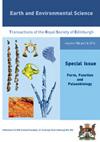A captorhinid-dominated assemblage from the palaeoequatorial Permian of Menorca (Balearic Islands, western Mediterranean)
IF 0.9
4区 地球科学
Q4 GEOSCIENCES, MULTIDISCIPLINARY
Earth and Environmental Science Transactions of the Royal Society of Edinburgh
Pub Date : 2021-06-01
DOI:10.1017/S1755691021000268
引用次数: 5
Abstract
ABSTRACT Moradisaurine captorhinid eureptiles were a successful group of high-fibre herbivores that lived in the arid low latitudes of Pangaea during the Permian. Here we describe a palaeoassemblage from the Permian of Menorca (Balearic Islands, western Mediterranean), consisting of ichnites of small captorhinomorph eureptiles, probably moradisaurines (Hyloidichnus), and parareptiles (cf. Erpetopus), and bones of two different taxa of moradisaurines. The smallest of the two is not diagnostic beyond Moradisaurinae incertae sedis. The largest one, on the other hand, shows characters that are not present in any other known species of moradisaurine (densely ornamented maxillar teeth), and it is therefore described as Balearosaurus bombardensis gen. et sp. nov. Other remains found in the same outcrop are identified as cf. Balearosaurus bombardensis gen. et sp. nov., as they could also belong to the newly described taxon. This species is sister to the moradisaurine from the lower Permian of the neighbouring island of Mallorca, and is also closely related to the North American genus Rothianiscus. This makes it possible to suggest the hypothesis that the Variscan mountains, which separated North America from southern Europe during the Permian, were not a very important palaeobiogeographical barrier to the dispersion of moradisaurines. In fact, mapping all moradisaurine occurrences known so far, it is shown that their distribution area encompassed both sides of the Variscan mountains, essentially being restricted to the arid belt of palaeoequatorial Pangaea, where they probably outcompeted other herbivorous clades until they died out in the late Permian.梅诺卡(地中海西部巴利阿里群岛)古赤道二叠纪的一个捕虏虫为主的群落
moradidisurine captorhinid真爬行动物是二叠纪时期盘古大陆干旱低纬度地区成功生存的一群高纤维食草动物。在这里,我们描述了一个来自梅诺卡岛(地中海西部的巴利亚利群岛)二叠纪的古组合,包括小的捕获兽形态的纯爬行动物,可能是moradiisaurines (Hyloidichnus)和副爬行动物(参见Erpetopus),以及两个不同的moradiisaurines分类群的骨头。两者中最小的那一种,除了moradidisaurinae intertae sedis外,不能诊断。另一方面,最大的一具化石所显示的特征,在其他已知的上颌骨牙齿(密集装饰的上颌骨牙齿)中是不存在的,因此它被描述为Balearosaurus bombardensis gen. et sp. 11 .,在同一露出地发现的其他遗骸被鉴定为cf. Balearosaurus bombardensis gen. et sp. 11 .,因为它们也可能属于新描述的分类单元。该物种是邻近马略卡岛二叠纪下的moradiisurine的姐妹,与北美的Rothianiscus属也有密切关系。这使得我们有可能提出这样的假设,即在二叠纪时期将北美与南欧分开的瓦里斯坎山脉,并不是一个非常重要的古地理屏障,阻止了moradiaurines的扩散。事实上,通过绘制迄今为止已知的所有moradidisurine的分布图,我们发现它们的分布区域包括了Variscan山脉的两侧,基本上被限制在古赤道泛大陆的干旱地带,在那里它们可能与其他食草进化支竞争,直到它们在二叠纪晚期灭绝。
本文章由计算机程序翻译,如有差异,请以英文原文为准。
求助全文
约1分钟内获得全文
求助全文
来源期刊
CiteScore
2.00
自引率
0.00%
发文量
21
期刊介绍:
Earth and Environmental Science Transactions (formerly Transactions of the Royal Society of Edinburgh: Earth Sciences) is a general earth sciences journal publishing a comprehensive selection of substantial peer-reviewed research papers, reviews and short communications of international standard across the broad spectrum of the Earth and its surface environments. The journal prides itself on the quality of its graphics and photographic reproduction. The Editors are keen to encourage interdisciplinary papers and Transactions also publishes occasional special symposia and invited volumes of specific interest.
We are currently in the process of digitising the archive of RSE Publications, and the archive of the Transactions, dating back to 1788, will be available from the back issues link on this site.

 求助内容:
求助内容: 应助结果提醒方式:
应助结果提醒方式:


